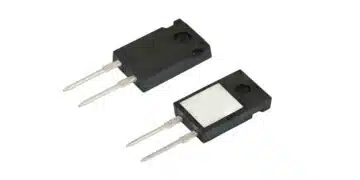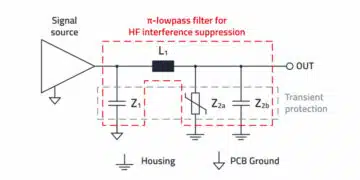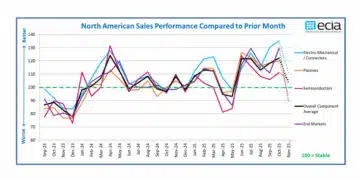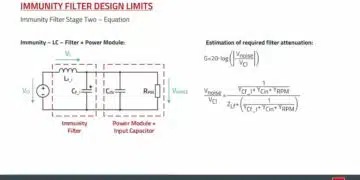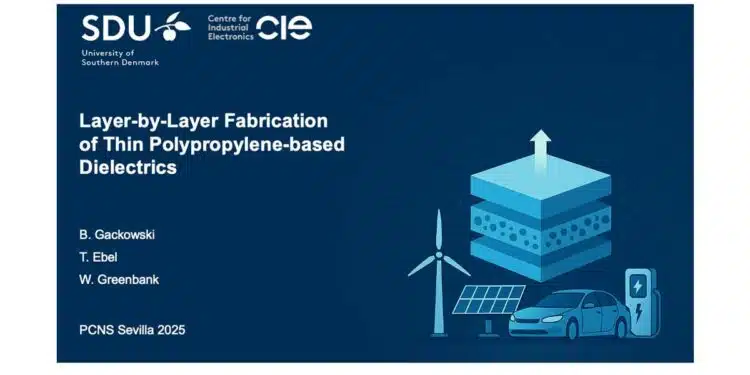The paper “Layer-by-Layer Fabrication of Thin Polypropylene-based Dielectrics” was presented by Bartosz Gackowski, Centre for Industrial Electronics, University of Southern Denmark, Sønderborg, Denmark at the 5th PCNS Passive Components Networking Symposium 9-12th September 2025, Seville, Spain as paper No. 4.3.
Introduction
Polymer film capacitors play a crucial role in electronic systems, such as automotive and renewable energy applications, where they are commonly used for filtering and smoothing power supply outputs.
Traditional film capacitors rely on polypropylene (PP) as the dielectric material because of its high dielectric breakdown strength, low dielectric loss, and scalability in production. However, PP suffers from a low dielectric constant (≈2.2), limiting energy density to about 1–4 J/cm³, which is below the approximately 5 J/cm³ achievable by aluminum electrolytic capacitors.
Increasing the dielectric constant without sacrificing breakdown strength and frequency stability is a key goal for next-generation capacitors. Layer-by-layer (LbL) fabrication techniques allow precise control of the dielectric structure, and incorporating nanoparticles such as barium titanate (BT) used in class II MLCC ceramic capacitors and silicon dioxide (SD) in silicon capacitors offers a path to enhancing performance through engineered nanocomposite dielectrics.
Key Points
- Objective: Improve the energy density of film capacitors by combining LbL fabrication with PP-based nanocomposites.
- Materials: Polypropylene (PP) inks with BT (~50 nm) and SD (~8 nm) nanoparticles, modified with either polymer coatings or surfactants (SDS or Triton X-100).
- Methodology: Multi-layer spin coating to produce five-layer capacitors, with top and bottom layers of neat PP and inner layers of nanocomposites; electrical properties characterized through impedance, ESR, and breakdown tests.
- Findings:
- Dielectric constant increased from 2.2 (PP) to 4.7 with SD nanocomposites.
- Hybrid BT-SD structures improved dielectric strength by 22% over neat PP.
- Optimal stacking arrangements significantly influenced breakdown strength.
- Energy density reached up to 4.1 J/cm³, roughly double neat PP.
- Challenges: Higher Equivalent Series Resistance (ESR) with surfactant-treated nanoparticles and sensitivity of dielectric strength to layer configuration.
Extended Summary
This research addresses the limitations of conventional polypropylene (PP) film capacitors by employing a layer-by-layer (LbL) fabrication method to integrate nanocomposite dielectrics. The approach leverages the controlled deposition of multiple thin polypropylene layers, interspersed with layers doped with nanoparticles to boost dielectric performance. Enhancing the dielectric constant while maintaining high breakdown strength is critical for achieving higher energy density in compact capacitors.
Nanoparticles of barium titanate (BT, 50 nm) and silicon dioxide (SD, 8 nm) were utilized to form nanocomposites. To address the common challenge of nanoparticle agglomeration and poor compatibility with PP, two surface modification strategies were implemented: using ionic (SDS) and nonionic (Triton X-100) surfactants or coating nanoparticles with a thin PP shell via anti-solvent displacement. Surfactant-assisted modification is simpler to implement but leaves residual surfactants in the dielectric, which can increase resistive losses. Polymer coating, on the other hand, enhances interfacial compatibility by matching the dielectric matrix but involves a more complex synthesis.
Film capacitors were fabricated via spin coating on glass substrates with titanium and silver bottom electrodes, followed by sequential deposition of PP and nanocomposite layers to form five-layer stacks. The top electrode was aluminum, patterned with a shadow mask to create multiple devices per sample. Electrical characterization included capacitance measurements across frequencies from 20 Hz to 10⁶ Hz, ESR evaluation, and DC breakdown testing up to 1000 V. Dielectric constant and energy density were calculated using the standard capacitor equations, with Weibull analysis applied to breakdown data.
Results demonstrated that untreated BT decreased the dielectric constant due to clustering and localized electric fields, while surfactant-treated BT achieved dielectric constants of 2.85–3.2. SD-doped layers provided the highest dielectric constant of 4.7, benefiting from smaller particle size and larger interfacial area. Frequency stability of the dielectric constant remained comparable to neat PP across the tested range, preserving suitability for high-frequency applications.
Breakdown strength, a critical factor for energy density, was highly sensitive to layer configuration. Certain layer sequences, such as PP–BT–SD–BT–PP, nearly tripled the breakdown strength of alternating SD-BT structures. Hybrid BT/SD nanocomposites achieved the best combination of high dielectric constant and improved breakdown strength, reaching 557 MV/m. Devices with total film thickness below 1 μm achieved energy densities up to 4.1 J/cm³—double that of neat PP—while maintaining acceptable ESR. However, devices with surfactant-modified nanoparticles showed significantly higher ESR, with Triton-treated samples exhibiting up to 20× higher resistance than neat PP.
These results highlight the strong interdependence of dielectric constant, breakdown strength, and ESR in nanocomposite film capacitors. Layer-by-layer fabrication allows precise compositional and structural optimization, enabling a trade-off between energy density and efficiency. The combination of BT and SD nanoparticles, particularly with polymer coating, offers a pathway to high-performance thin-film capacitors that could reduce the size and weight of power electronic systems.
Conclusion
The study demonstrates that LbL-fabricated polypropylene-based nanocomposite dielectrics can significantly enhance the energy density of film capacitors by tuning layer composition and nanoparticle treatment. Key achievements include doubling the energy density to 4.1 J/cm³, enhancing dielectric constant to 4.7, and improving breakdown strength by 22% over neat PP. Optimal stacking and nanoparticle modification strategies are critical for minimizing ESR and achieving reliable performance. This work reinforces the potential of structural and compositional optimization in advancing next-generation high-energy-density film capacitors for automotive, renewable energy, and other demanding electronic applications.



